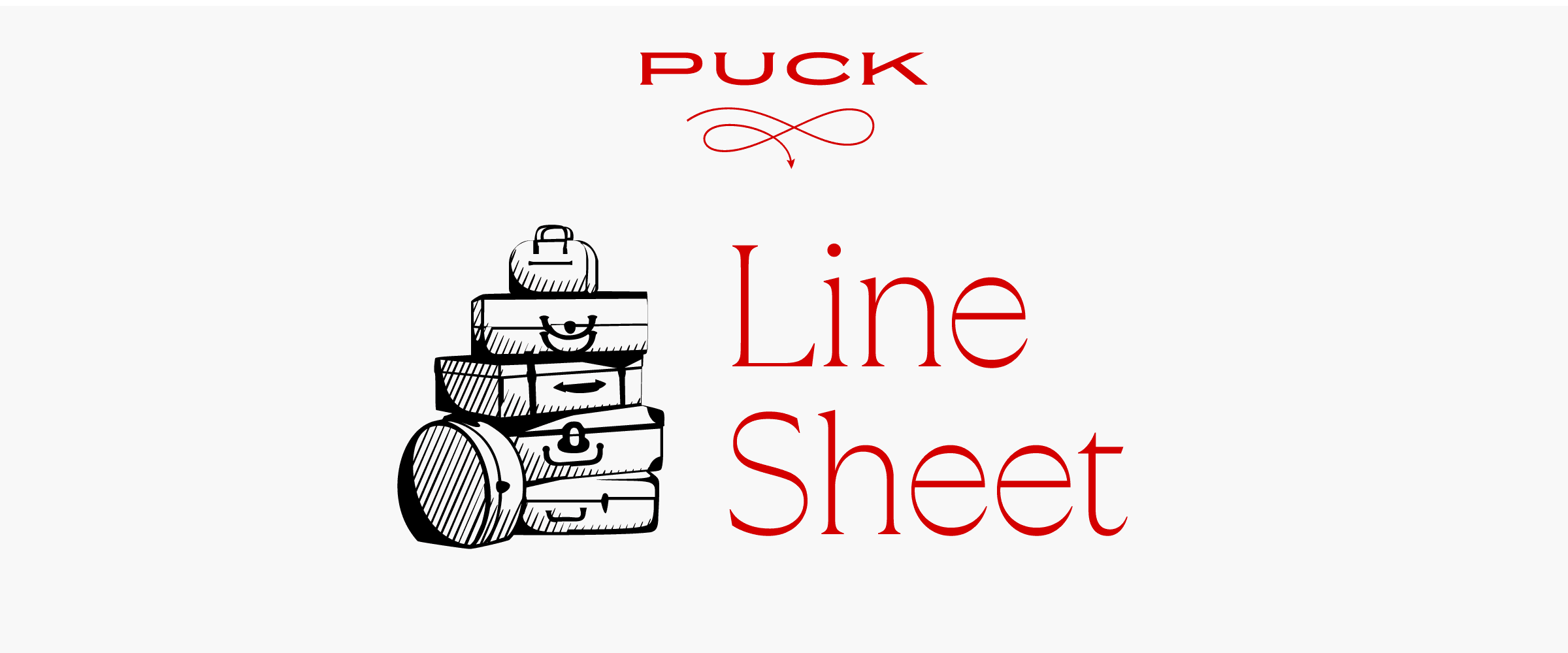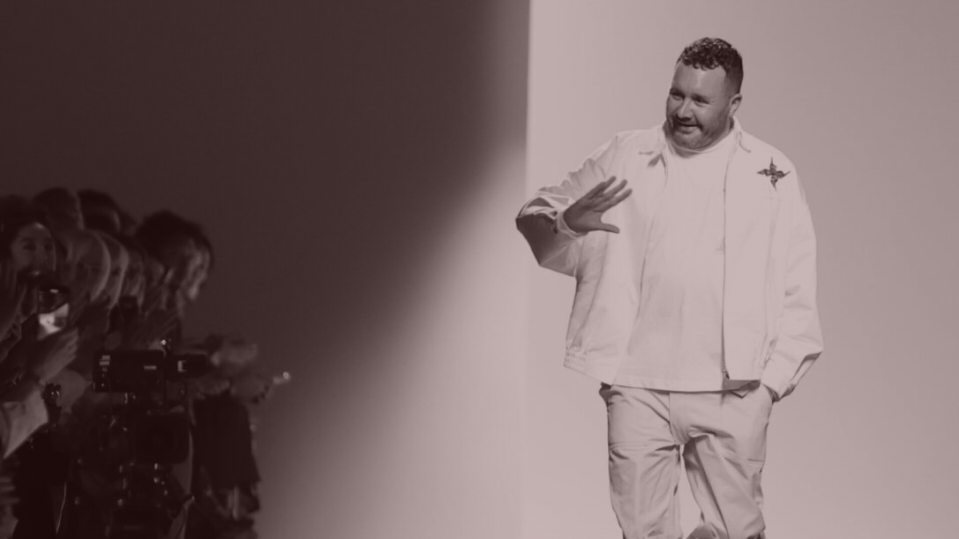 |
|
Hi, and welcome back to Line Sheet. I’m now firmly planted in Los Angeles after three runway shows in three different cities, two Puck events, three trips to Altro Paradiso (two within eight hours of each other), one appearance at Mr. Chow in Tribeca, a hot water with lemon at Sant Ambroeus uptown, and as many Wolseley flybys as days I was in London. For the last leg of my trip, I also swung by the Savannah College of Art and Design’s annual fashion show (much more on that below).
🚨🚨 Programming note: Tomorrow on Fashion People, New York Times reporter Jessica Testa, one of my favorite fashion writers (and writers in general), is joining me for our weekly riff on the latest industry news. Like, subscribe, and listen here. (Oh, and if you haven’t yet subscribed to Puck, you know what I think of you. Improve your ranking in my mind and join in on our fun.)
Mentioned in this issue: Dirk Standen, Vogue, SCAD, Anna Wintour, Condé Nast, Roger Lynch, Zendaya, Loewe, Mara Hoffman, Kim Jones, Chris Benz, Scott Sternberg, Aurora James, LVMH, Delphine Arnault, Michael Burke, Liana Satenstein, Plum Sykes, Nicolas Bos, and many more.
- Things fall apart: On Sunday, New York designer Mara Hoffman announced that she was putting her business on pause, effectively shutting it down, at least for a little while. Last year at the CFDA Awards, where she was honored for her work on environmental sustainability, Hoffman intimated to me that she wasn’t sure she’d be able to keep moving forward with the brand. I didn’t find her disclosure all that concerning or unusual. Designers say as much to me all the time: Most live on the verge of quitting, their attitude dependent on current cash flow.
Hoffman had sales, however. In fact, her sales had increased dramatically after two decades in business, when she found new success with a series of dresses made from a stretchy popcorn fabric that became a wedding guest go-to—and happened to fit a range of bodies without feeling like inclusivity propaganda. Suddenly, Mara Hoffman, once dismissed as a resort wear brand, was part of the American fashion conversation.
Few designers have the constitution to quit, let alone announce it publicly. Chris Benz, who became my friend over the years I wrote about him, told me that shutting down his namesake brand was like ending a television series before it went to the dogs. Scott Sternberg, who buried Band of Outsiders and Entireworld before their perceived expiration date, employs a similar attitude. Often, these lines are discontinued because the funding isn’t there. The funding is typically gettable; it just may not be coming from an ideal source, and designers have to decide whether they are willing to live with the tradeoffs.
Hoffman has expressed that it is heartbreakingly difficult to make and sell clothes in an environmentally responsible way, which I assume is a big part of why she decided to pack it in. There is an argument that producing anything new at the moment is irresponsible. Call me a climate defeatist, but my whole feeling, and the reason I don’t like to use the S-word (sustainability), is that there isn’t much that people can do on a micro level. Fashion can only be improved by drastic changes in public policy. And yet, that shouldn’t diminish Hoffman’s efforts. She tried.
- Let’s toast to summer Fridays, I guess?: The report from the Condé Nast cocktail hour on Thursday night, just a couple of days after the announcement of chief revenue officer Pamela Drucker Mann’s exit, was that a lot of people showed up, including Anna Wintour. While Drucker Mann’s team feels defeated—with some wishing they could walk out with her, Jerry Maguire style—most Nasties viewed it as yet another retrenchment.
Alas, it also unearthed additional fissures at the joint. Multiple fairly senior people on the editorial side admitted that they had never even heard Drucker Mann’s name before reading about her departure last week. Therein lies the problem with this company: Drucker Mann should have been almost as significant a figure to them as Wintour. But there’s zero “We’re all in this together” vibes. Perhaps Roger Lynch, who has been spending an increasing amount of time in California, I’m told, will use Drucker Mann’s departure this summer as an opportunity to coalesce.
- Opening remarks: Lucky for all you fashion people, my Puck partner (and resident legal expert) Eriq Gardner has a story today about the antitrust-happy Federal Trade Commission’s effort to block the merger between Tapestry and Capri on the grounds that it squeezes consumers of so-called accessible luxury. The trial likely won’t happen until September—not great for the brands of Capri, who have stuff to do and are stuck in limbo. But in a May 10 court brief, Tapestry made the argument that the F.T.C.’s definition of accessible luxury was bogus, that there were far more brands in competition, and the consolidation of Coach and Michael Kors wasn’t going to screw over anyone. (I’d agree with that position.)
Notably, Tapestry also suggested in the brief that it was buying Capri to “save” the Michael Kors brand—that it’s currently in dire straits and the only way to fix it is to bring it under the Tapestry umbrella, etcetera. Yes, Coach is in a stronger financial position than Kors, but the two brands employ a very similar strategy, and the labels under the Capri umbrella—Kors, Jimmy Choo, and Versace—are far more prestigious than Tapestry’s portfolio of Coach, Stuart Weitzman, and Kate Spade New York. The reality of the matter: Tapestry has always appeared more focused on quarterly performance than its peers—it used to be run by a former Goldman banker—and the company covets Capri to move more product to inevitably increase shareholder value. But let Eriq fill you in on the rest.
- It’s On for Zendaya: The Bulgari and Louis Vuitton ambassador is also linking up with On, the running shoe and lifestyle company, I hear. As for whether it’s a collaboration, a simple advertising campaign, or something entirely different, I don’t know, but they are partnering. (Reps for Zendaya and On Running did not immediately respond to a request for comment.)
This deal makes a lot of sense. Sure, Zendaya is expensive—industry sources have pegged her Louis Vuitton deal as the most lucrative deal of its type in history—but she is arguably Hollywood’s most important young star, and the partnership smartly builds off On’s impressive product placement in Challengers. And there is plenty of space for a brand like On to pick up the slack from Nike and Adidas, which ceded the space for super-upmarket, non-performance footwear. On was already a favorite of the second-home crowd; then came the Roger Federer association and the ongoing collaboration with Loewe. The jazziness of the Loewe design made the shoes a fashion item, too. The latest fruits of the collaboration between the LVMH-owned brand and On officially drop May 23, (you can preorder them May 21), and I might even buy some of the clothes.
|
 |
| South by Southeast |
| A little trip to see Dirk & Co. leads to some dish on young designers, Kim Jones’ fate, Gucci, Chloé, and the evolving LVMH sitch. |
|
|
|
| On Thursday, en route from London, I flew over to Savannah, of all places, to attend SCAD’s annual fashion show. Dirk Standen, the former Style.com editor and current dean of fashion at the Savannah College of Art and Design, invited me—but also, I’ve always been charmed and intrigued by SCAD, a young school (45 is the new 30) that has managed to establish itself as a formidable competitor in the industrial race to shape creative minds. André Leon Talley, for example, had a relationship with the school for nearly 20 years, cajoling his friends and acquaintances to join him for various goings-on. SCAD was where I met the late Julia Reed, a former Vogue editor and close friend of Hamish Bowles. Also, everyone in Savannah dresses up.
The school’s annual fashion show is a chance to showcase top design talent from both the Savannah and Atlanta campuses, not only to proud parents but also industry insiders who make the pilgrimage. Among the crowd in town during my stay: SCAD alum and Vogue Runway writer José Criales-Unzueta; Vogue’s Virginia Smith and her husband, the designer Patrick Robinson; my old BoF colleague Robin Mellery-Pratt; Neiman Marcus’s Bruce Pask; and Brother Vellies’ Aurora James, who was presented with the ALT Award, among others.
Paula Wallace, SCAD’s founder and president, realized long ago that luring creative leaders to the city’s untouchable Spanish moss and haunted Victorians would burnish the still-nascent organization’s reputation. But Standen’s appointment as dean, after the 2021 retirement of former Saks fashion director Michael Fink, may have increased the ambition. I’m not sure an education can get you as far as it did a generation or so ago, back when Louise Wilson, the famous Central Saint Martins professor, taught McQueen, Jonathan Saunders, Christopher Kane, and others. Of all the American fashion schools, SCAD has always been focused on getting kids actual, practical jobs, despite not being embedded in the internship ecosystem in New York. At the same time, because of its distance from Manhattan, there is less of a material industry influence on the work the students produce there.
There are some breakout-star stories—Christopher John Rogers, who graduated in ’16, being the biggest—and there will likely be more. However, it’s the stories of designers like Julian Robaire (B.F.A. fashion, 2013), who was just named Chanel’s V.I.P. atelier director, that underscore SCAD’s legitimacy. I’m not a big fan of student shows, generally—I don’t have the patience—but Friday’s effort was packed with ideas and a sense of optimism. My favorites were Chuck Ryan’s graph-paper vision of what a Beastie Boy might dress like in 2024, Gonnie Weinstock’s Welcome to the Dollhouse polka dots, and Yutong Zhao’s rattan accessories.
Studying to be a fashion designer, much like studying journalism, can seem like a bizarre choice in this economic moment. The way these kids dress in their classrooms, a vision of a Glenn Martens mood board in JNCOs and muddy grey t-shirts, makes me think they’ve also read that Guardian piece from a few weeks back that essentially says we’re all going to die. It’s easy to keep things superficial in an era when things feel so dire, and other people’s work is so accessible, so simple to copy. And yet, these kids are putting their whole selves in. Good for them, and good for Dirk.
|
|
|
| The night before the SCAD fashion show, at a wine bar serving nothing but Pét-Nat and jammy reds, a crew of us got into it regarding the still-new creative direction at both Gucci and Chloé. We agreed that, on principle, the clothes were fine, often more than fine. But given the prices, wouldn’t it make more sense just to buy the real thing, meaning… vintage? I’m convinced that the market for secondhand luxury goods is hurting fashion brands more than they realize. Especially with first adopters who influence the wealthier lemmings.
A case in point: The morning after our chat, Interview editor-in-chief Mel Ottenberg posted selects from The RealReal as part of a marketing partnership. As I started combing through, I spied a tweed Prada suit, a Norma Kamali scarf dress, and a velvet Alaïa bodice-ripper. It inspired me to shop. (I bought a scrunchy Tom Ford-era YSL dress.) Look, we all know that these second-hand sites are over-leveraged and lack a convincing long-term business model. And yet, fashion consumers want to buy what they’re selling. On a smaller scale, propositions like Desert Vintage in New York and Tucson, and James Veloria in New York and Los Angeles, are influencing the broader market.
It’s something the folks over at LVMH should be thinking about, especially as the group continues to organize itself for the future. I heard from quite a few sources after my story last week, many of whom were eager to offer their thoughts on why the company is covertly shifting duties away from Fashion Group C.E.O. Michael Burke, who has suddenly, if temporarily, stepped aside. Many people underscored that my reporting around the Alessandro Michele contract kerfuffle checks out, but that the clandestine shuffling of work probably has very little to do with it.
The concern among insiders is that the former fashion group C.E.O. Sidney Toledano, while loved, is not the right person to lead the next phase of the business. (As I said the other day, Delphine Arnault has already taken on some of Burke’s responsibility, but it probably does not make sense to move her off of Dior at this juncture.) I was also urged to keep an eye on Pierre-Emmanuel Angeloglou, Burke’s consigliere at Louis Vuitton, who was promoted to deputy C.E.O. of the group in March. Angeloglou, who directly looks after all the so-called tiny brands—including Stella McCartney, Fendi, and Marc Jacobs—was only at Louis Vuitton for a few years. Like many newer LVMH executives, he comes from the world of brand management. (In this case, L’Oreal.)
Meanwhile, the rumor mill concerning Kim Jones’ fate at Fendi is more active than ever, even among his own team, although a person close to him continues to deny that he’s going anywhere. Jones, like many top designers still working today, studied under Wilson, the aforementioned Saint Martins professor. Unlike the SCAD students, however, the Wilson collective wasn’t encouraged to be business-minded. But it comes naturally to Jones, who is an excellent product designer with a knack for merchandising, which has allowed him to succeed at the two biggest brands in the world, Louis Vuitton and Dior. My assumption is that anyone who has made LVMH as much money as Jones will be taken care of in one way or another… Perhaps that means he gets to keep at least one of his jobs, if not both; perhaps that means he’ll be given a new opportunity. No matter what happens in this new era of the business, LVMH will keep following the money.
|
|
|
| Best of Cannes: Julianne Moore in Bottega Veneta, Cate Blanchett in Louis Vuitton, Alexa Chung in Celine (exactly what I would want to wear), Hunter Schafer in Prada and Armani Privé and this (she wins). Also: Kirsten Dunst and Jesse Plemmons in Gucci, Selena Gomez in Saint Laurent, Richard Gere and Uma Thurman.
Two originals: Liana Satenstein interviews Plum Sykes!!! [Neverworns]
Generic Ozempic is here! [Bloomberg]
People on Reddit were very mad that Glossier changed the formula of its Balm Dotcom. Glossier used the hate to its advantage when it returned to the original formula. [AdAge]
Romy Mars—a second coming of Sofia, slathered in Drunk Elephant Anti-Pollution Sunshine Drops—has arrived. [Town & Country]
At least he looks normal again? [Page Six]
A lot of the Doen x Gap stuff is sold out, but here’s a good review of what to buy if and when it gets replenished. [Hillary Kerr’s Substack]
Richemont has a new group C.E.O.: Van Cleef & Arpels’ Nicolas Bos. [WWD]
And finally… let’s bring back dressing up in airports.
|
|
|
Until Wednesday,
Lauren |
|
|
|
| FOUR STORIES WE’RE TALKING ABOUT |
 |
|
 |
| Zuck’s Gambit |
| Dissecting Meta’s plunge into A.I. |
| BARATUNDE THURSTON |
|
 |
|
 |
| $1B Art Flop |
| Chronicling a topsy-turvy week for the art market. |
| MARION MANEKER |
|
|
|
|
|
 |
|
|
|
Need help? Review our FAQs
page or contact
us for assistance. For brand partnerships, email ads@puck.news.
|
|
You received this email because you signed up to receive emails from Puck, or as part of your Puck account associated with . To stop receiving this newsletter and/or manage all your email preferences, click here.
|
|
Puck is published by Heat Media LLC. 227 W 17th St New York, NY 10011.
|
|
|
|







